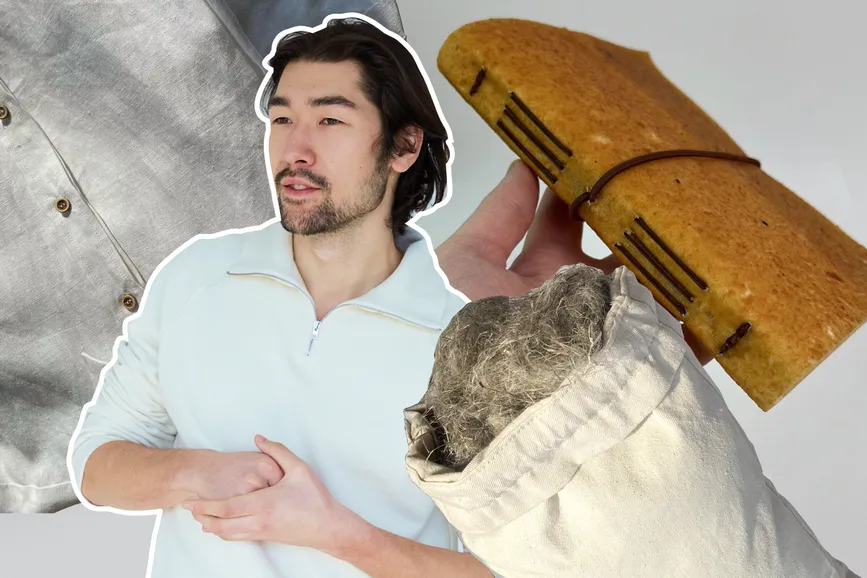As the first brand in Kazakhstan to produce clothes from hemp, ages & ages positions itself as a thought leader in mindful consumption. In 2022, the fashion house was featured in Samsung’s AI Ecobubble campaign event in Almaty, consolidating its status as a future-oriented, environmentally conscious business.
Tomas Akynov, who founded ages & ages, told QazMonitor his condition for creating a brand was that it had to be eco-friendly. For that he recruited a small R&D team consisting of researchers Karina Abysheva and Gulnaz Sarsenova and designer Dilyara Kozhakhmetova. Each member specializes in finding innovative solutions for sustainable fashion and textile, like developing vegan leather from coffee and apple skin.
United by a passion for raising environmental awareness, the team designs and launches clothing collections that promote slow fashion and a taste for eco materials like hemp, which has yet to reach commercial popularity in Kazakhstan.
Slow fashion
What are the advantages of fabric made of hemp?
T. Industrial hemp is more environmentally friendly to produce. It doesn't require huge amounts of water. We've seen this from secondary data – clothing made from hemp needs 90% to 95% less water when compared to cotton. Hemp acts as a fertilizer and does not need pesticides or chemicals to grow.
K. Hemp can be grown several times a year and there is no need for the soil to rest. Flax is grown this way: the next crop is sown immediately after the first harvest without giving the soil a break. But here the soil loses its nutritional value. In this sense, hemp is better than cotton – we can repeatedly plant and grow it without affecting the soil.
Slow fashion runs in parallel with sustainable fashion – we slow down our consumption and buy fewer but higher quality clothes.
T. As for the downsides, it’s an organic material, so it requires more care. It needs to be washed less or with extreme care. It also wrinkles more, which is not very convenient.
Who are you selling sustainable wear to?
T. Our choice of a target audience was based on production cost. The fabrics we bought from India or through suppliers in Russia and China were expensive. Over time, we realized that we wanted to target the class of buyers who value quality, eco-friendly clothes and can afford paying ₸60,000 or more for them. Our brand and the kind of story we tell are geared toward an older audience who are in their 30s and up. There are other brands in Kazakhstan who target a younger audience with an average price tag of ₸20,000. And it's great that we have competitors who each focus on a specific demographic.
Sustainable style
What kind of products do you offer and what is taken into account when creating a new collection? Right now you seem to be focused on men's wear.
T. The first collection was created before our team was formed – it was purely my desire to create it and I was advised to focus on the male audience. However, as it turned out, 6 out of 10 customers are women who buy for themselves. The sizes were large, though not over-sized, and designed for men. The next collection included women’s and unisex looks.
You could create something for one audience and have a completely different audience show interest instead.
D. Our new collection is called Ocean Chic. We wanted to convey the atmosphere of seaside countries and demonstrate how people there dress in the summer. The pieces are mostly casual, but you can also wear them to work. Overall, they are very comfortable.
A future with bio leather
Gulnaz and Karina mentioned that they have been working on developing plant-based eco leather. How close are you to incorporating it in your future collections?
G. From my studies, I had already known about sustainable fashion and the existence of materials such as “piñatex” made of pineapple and “mylo” made of mushrooms. I thought, "Why not create textiles like these?"
They’re still in their research and development phase. The materials aren’t suitable for clothing yet since they tend to expand and fall apart after a wash and aren’t as resistant to tear as ordinary leather. They can withstand four kilograms, which is enough to make a notepad cover – and we had tried to make one. But the problem was that the leather, especially the one made from coffee, would curl. Now we would like to explore how to make the material stronger and improve its visual characteristics.
What kind of support is needed for the research and development of eco fabric?
T. I’m at NU now, so we have applied to an accelerator program there. But our apple skin idea is still in its early stages, and their incubator is for working projects. We plan to apply for the Social Development Fund, which would provide a ₸5 million grant. This amount will be enough to increase production and bring in foreign expertise. We have friends studying in foreign universities who can help connect us to global research centers. So, we are looking for funding not only in Kazakhstan but internationally, too.
G. Projects like creating bio-leather are hard to find, and at my university, for example, there is no one who knows what to do with them.
K. This is true for not only the CIS region but the whole world.
Gulnaz said earlier that there are all sorts of materials; but most of them aren’t biodegradable because they contain plastic. What she is trying to do is create a completely sustainable material. This is not a marketing ploy – it’s real bio leather.
